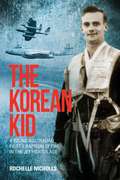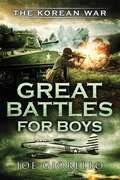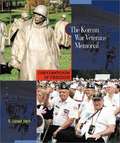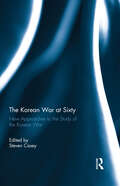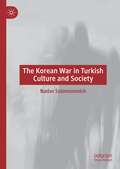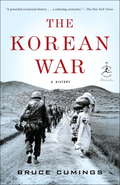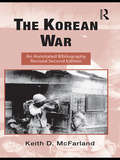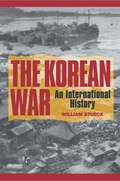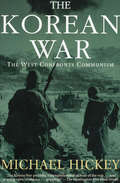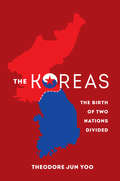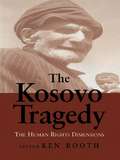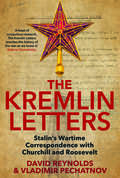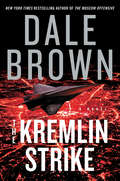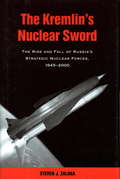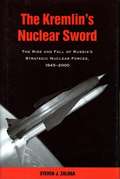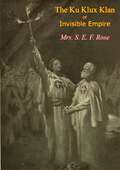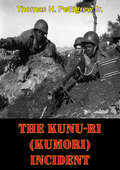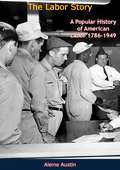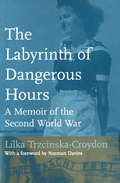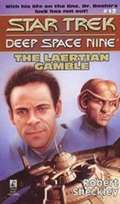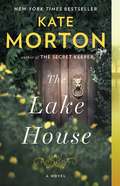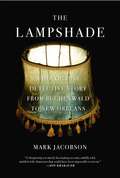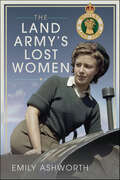- Table View
- List View
The Korean Kid: A Young Australian Pilot's Baptism of Fire in the Jet Fighter Age
by Rochelle NichollsA vicious civil conflict erupted on the Korean peninsula in 1950 and sucked 24 nations into a new round of fighting. The world’s two atomic superpowers – the United States and the Soviet Union – menaced each other across an arbitrary border as Korea became the proving ground for a new Cold War. The odds faced by Australia’s young pilots were one in three, that they’d not come back. Or perhaps they’d just never be found, crash in flames into a foreign mountain and become nothing but names in a faraway cemetery. Most had no combat experience. Their planes were obsolete. Their orders were to dive upon a well-armed enemy with their bellies exposed, where one bullet to a fuel-tank meant an inescapable fireball. The Korean Kid is the story of Jim Kichenside and the Australian pilots who took to the skies in the ‘forgotten war’ on the Korean peninsula. Within a week of the North Korean invasion of the South on June 25, 1950, No.77 Fighter Squadron RAAF were in the air: the first United Nations air unit committed to the defence of the overrun South. Of the 340 Australians who perished in Korea, 41 were from 77 Squadron. In 1952, Jim Kichenside was the youngest pilot in 77 Squadron, at just 21 years of age. He entered the Korean theatre with just 8 hours of training on his Meteor jet. Dubbed ‘The Korean Kid’, Jim's is a story of youth and resilience, of luck and loss, of young men thrust into a war against impossible odds – the first war of the jet age.
The Korean War (Great Battles for Boys)
by Sibella Giorello Joe GiorelloEach book in the series focuses on the battles, leaders, tactics, and weapons that won (or lost) history’s most significant military clashes. Filled with historic photos and written in an engaging conversational style by a middle school history teacher, Great Battles for Boys brings history to life. These true tales of courage will excite even the most reluctant readers. <p><p> In this seventh book in the series, boys learn about The Korean War (1950-53) also known as the “The Forgotten War.” Despite more than 2 million casualties, most people—young and old—can not fully explain this international conflict or why the United States sacrificed so much treasure to fight it.
The Korean War Remembered: Contested Memories of an Unended Conflict (Studies in War, Society, and the Military)
by Michael J. DevineMichael J. Devine provides a fresh, wide-ranging, and international perspective on the contested memory of the 1950–1953 conflict that left the Korean Peninsula divided along a heavily fortified demilitarized zone. His work examines &“theaters of memory,&” including literature, popular culture, public education efforts, monuments, and museums in the United States, China, and the two Koreas, to explain how contested memories have evolved over decades and how they continue to shape the domestic and foreign policies of the countries still involved in this unresolved struggle for dominance and legitimacy. The Korean War Remembered also engages with the revisionist school of historians who, influenced by America&’s long nightmare in Vietnam, consider the Korean War an unwise U.S. interference in a civil war that should have been left to the Koreans to decide for themselves. As a former Peace Corps volunteer to Korea, a two-time senior Fulbright lecturer at Korean universities, and former director of the Harry S. Truman Presidential Library, Devine offers the unique perspective of a scholar with half a century of close ties to Korea and the Korean American community, as well as practical experience in the management of historical institutions.
The Korean War Veterans Memorial (Cornerstones of Freedom, 2nd Series)
by R. Conrad SteinThe Korean War is called the "Forgotten War." The conflict was largely ignored by the American public while it raged. Even today the war is covered by only a few paragraphs, rather than a chapter, in the history books. But those who fought in Korea will never forget the terror and the misery they suffered there. For the rest of their lives they will have painful memories of friends who were killed in that faraway land.
The Korean War at Sixty: New Approaches to the Study of the Korean War
by Steven CaseyKorea used to be the ‘forgotten war.’ Now, however, experts widely view it as a pivotal moment in the history of the Cold War, while its legacy still scars contemporary East Asian politics. The sixtieth anniversary of the Korean War is a fitting time both to assess the current state of historiography on the conflict and to showcase new research on its different dimensions. This book contains six essays by leading experts in the field. These essays explore all aspects of the war, from collective security and alliance relations, to home front politics and historical memory. They are also international in scope, focusing not just on the familiar Western belligerents but also on the actions of the two Koreas, China and the Soviet Union. These stimulating essays shed new light on various aspects of the Korean War experience, as well as examining why the war remains so important to the politics of the region. This book was originally published as a special issue of Journal of Strategic Studies.
The Korean War in Turkish Culture and Society
by Nadav SolomonovichThis book explores the important role that the Korean War played in Turkish culture and society in the 1950s. Despite the fact that fewer than 15,000 Turkish soldiers served in Korea, this study shows that the Turkish public was exposed to the war in an unprecedented manner, considering the relatively small size of the country’s military contribution. It examines how the Turkish people understood the war and its causes, how propaganda was used to ‘sell’ the war to the public, and the impact of these messages on the Turkish public. Drawing on literary and visual sources, including archival documents, newspapers, protocols of parliamentary sessions, books, poems, plays, memoirs, cartoons and films, the book shows how the propaganda employed by the state and other influential civic groups in Turkey aimed to shape public opinion regarding the Korean War. It explores why this mattered to Turkish politicians, viewing this as instrumental in achieving the country’s admission to NATO, and why it mattered to Turkish people more widely, seeing instead a war in the name of universal ideas of freedom, humanity and justice, and comparing the Turkish case to other states that participated in the war.
The Korean War: A History (Modern Library Chronicles)
by Bruce CumingsAs Cumings eloquently explains, for the Asian world the Korean War was a generations-long fight that still haunts contemporary events. He shares the neglected history of occupation of Korea and the untold stories of bloody insurgencies and rebellions in that divided land.
The Korean War: An Annotated Bibliography (Routledge Research Guides to American Military Studies)
by Keith D. McFarlandThe Korean War is the most comprehensive and detailed bibliography compiled to date on the American involvement in "The Forgotten War." In this revised and expanded second edition, Keith D. McFarland’s clearly written annotations provide concise descriptions of more than 2,600 of the most important books, articles, and documents written in English on the conflict in Korea. Key topics include origins of the war; the political and military roles of North and South Korea, the United States, the Soviet Union, China, Great Britain, Canada, Australia, South Africa, Turkey, and other United Nations members; campaigns and battles; weapons and uniforms; and the military and diplomatic aspects of the war. Specific subjects are easy to find using the index organized by topic and author, making The Korean War a necessity for every academic or research library.
The Korean War: An International History (Princeton Studies in International History and Politics #68)
by William StueckThis first truly international history of the Korean War argues that by its timing, its course, and its outcome it functioned as a substitute for World War III. Stueck draws on recently available materials from seven countries, plus the archives of the United Nations, presenting a detailed narrative of the diplomacy of the conflict and a broad assessment of its critical role in the Cold War. He emphasizes the contribution of the United Nations, which at several key points in the conflict provided an important institutional framework within which less powerful nations were able to restrain the aggressive tendencies of the United States. In Stueck's view, contributors to the U.N. cause in Korea provided support not out of any abstract commitment to a universal system of collective security but because they saw an opportunity to influence U.S. policy. Chinese intervention in Korea in the fall of 1950 brought with it the threat of world war, but at that time and in other instances prior to the armistice in July 1953, America's NATO allies and Third World neutrals succeeded in curbing American adventurism. While conceding the tragic and brutal nature of the war, Stueck suggests that it helped to prevent the occurrence of an even more destructive conflict in Europe.
The Korean War: The West Confronts Communism
by Michael HickeyAn authoritative account by the historian and Korean War vet offers &“a comprehensive picture of the war . . . and riveting tales of heroics . . . Gripping&” (The Washington Post Book World). Winner of the Westminster Medal for Military Literature On June 25, 1950, the North Korean People&’s Army shocked American troops by crossing the 38th parallel into South Korea. After five years of relative quiet following the close of World War II, the US Army was unprepared to face a battle-ready enemy. After an initial defeat, General MacArthur turned the tides along with significant contributions from UN allies. Joining the Americans were troops from Britain, Australia, Canada, New Zealand, South Africa, Turkey, and elsewhere, working together despite problems of culture and logistics. In The Korean War, Michael Hickey frames the conflict in the larger context of international power politics. A veteran of the war himself, he recounts such masterstrokes as MacArthur&’s landing behind the enemy lines at Inchon, the drama of the glorious Glosters episode, and both collaboration and mutiny in the prisoner-of-war camps of either side. Drawing on many previously unexamined sources from several countries, including recently declassified documents, regimental archives, diaries, and interviews, Hickey adds extensively to our knowledge of one of the most significant conflicts of modern times. &“[A] fine, opinionated contribution to Korean War literature . . . Not to be missed.&” —Publishers Weekly
The Koreas: The Birth of Two Nations Divided
by Theodore Jun YooWhat history, pop culture, and diaspora can teach us about North and South Korea today.Korea is one of the last divided countries in the world. Twins born of the Cold War, one is vilified as an isolated, impoverished, time-warped state with an abysmal human rights record and a reclusive leader who perennially threatens global security with his clandestine nuclear weapons program. The other is lauded as a thriving democratic and capitalist state with the thirteenth largest economy in the world and a model for developing countries to emulate. In The Koreas, Theodore Jun Yoo provides a compelling gateway to understanding the divergent developments of contemporary North and South Korea. In contrast to standard histories, Yoo examines the unique qualities of the Korean diaspora experience, challenging the master narratives of national culture, homogeneity, belongingness, and identity. This book draws from the latest research to present a decidedly demythologized history, with chapters focusing on feature stories that capture the key issues of the day as they affect popular culture and everyday life. The Koreas will be indispensable to any historian, armchair or otherwise, in need of a discerning and reliable guide to the region.
The Kosovo Tragedy: The Human Rights Dimensions
by Ken BoothThe 1999 conflict in Kosovo is seen as being as significant for international affairs as the pulling down of the Berlin Wall, because of the centrality of human rights in the build-up, conduct and aftermath of the war. This volume is an attempt to explore this human rights tragedy.
The Kremlin Letters: Stalin's Wartime Correspondence with Churchill and Roosevelt
by David Reynolds Vladimir PechatnovA penetrating account of the dynamics of World War II’s Grand Alliance through the messages exchanged by the "Big Three" Stalin exchanged more than six hundred messages with Allied leaders Churchill and Roosevelt during the Second World War. In this riveting volume—the fruit of a unique British-Russian scholarly collaboration—the messages are published and also analyzed within their historical context. Ranging from intimate personal greetings to weighty salvos about diplomacy and strategy, this book offers fascinating new revelations of the political machinations and human stories behind the Allied triumvirate. Edited and narrated by two of the world’s leading scholars on World War II diplomacy and based on a decade of research in British, American, and newly available Russian archives, this crucial addition to wartime scholarship illuminates an alliance that really worked while exposing its fractious limits and the issues and egos that set the stage for the Cold War that followed.
The Kremlin Strike: A Novel (Brad McLanahan #5)
by Dale BrownIn this exciting, visionary, and all-too-plausible next chapter in the legendary Dale Brown’s New York Times bestselling techno-warfare series, Brad McLanahan and the Iron Wolf Squadron must fight the Russians on a dangerous, untested battlefield: outer space.The previous administration’s ineffective response to the growing Russian threat has left America vulnerable. Setting a bold course for America’s defense, the decisive and strong new president, John Dalton Farrell, intends to challenge Russian aggression head on. Brad and Patrick McLanahan and the formidable Iron Wolf Squadron—including the recently injured Nadia Roz, rested and back to fighting form thanks to a pair of state-of-the-art prosthetic legs—are ready and eager to join the battle. But even with their combined forces, the Russian menace may prove too great for the Americans to overcome. Done with provocative skirmishes and playing for small stakes, the Russian president has set his sights on the ultimate prize: controlling the entire world. Expanding beyond earth’s bounds, the Russians have built a new high-tech space station and armed it with weaponry capable of destroying US satellites as well as powerful missiles pointed at strategic targets across earth.Devising a cunning plan of attack, Brad, Nadia, and the Iron Wolf warriors will take to the skies in their advanced space planes to destroy the space station, check the Russians’ plan for dominance, and save the world. But is it already too late?
The Kremlin's Nuclear Sword
by Steven J. ZalogaThe prevailing Western view of Russia's Cold War strategic nuclear weapons policy is that it resulted from a two-part interplay between the leaders of the Communist Party and the military. Steven J. Zaloga has found that a third contributor--the Russian defense industry--also played a vital role.Drawing from elusive Russian source material and interviews with many proud Russian and Ukrainian engineers, Zaloga presents a definitive account of Russia's strategic forces, who built them, and why. The book is the first in English to refer to the weapons by their actual Soviet names, providing the bedrock for future works. Helpful appendices list U.S., NATO, and other designations, and the illustrations provide clear visual references.
The Kremlin's Nuclear Sword: The Rise and Fall of Russia's Strategic Nuclear Forces, 1945-2000
by Steven J. ZalogaA voluminous writer on arms trading and technology, Zaloga explores the development of the Soviet Union and Russian strategic nuclear forces, focusing primarily on the offensive forces though looking at strategic defensive forces when necessary. The intercontinental ballistic missile being the most important element of the forces, it sits at the center of the study. Annotation c. Book News, Inc. , Portland, OR (booknews. com)
The Ku Klux Klan or Invisible Empire
by Mrs S. E. F. RoseMrs. S. E. F. Rose’s book, "The Ku Klux Klan: or Invisible Empire," provides a detailed historical account of the infamous white supremacist organization known as the Ku Klux Klan. First published in the late 19th century, this work delves into the formation, evolution, and ultimate decline of the Klan during its first incarnation following the American Civil War.The book begins with an exploration of the post-war Southern United States, setting the stage for the emergence of the Klan as a secret society founded by Confederate veterans. Rose examines the socio-political conditions that contributed to the Klan's rise, including the tumultuous Reconstruction era, widespread racial tensions, and the disenfranchisement of white Southerners.Rose's narrative is rich with firsthand accounts and detailed descriptions of the Klan's activities, rituals, and hierarchy. She provides insight into the organization’s use of terror and violence to maintain white supremacy and resist the integration and empowerment of African Americans. The book also discusses the internal conflicts and external pressures that led to the Klan's disbandment in the early 1870s.Though written from a perspective sympathetic to the Southern cause, Mrs. Rose's work is an important historical document. It offers readers a window into the mindset of Klan members and their supporters, while also highlighting the broader implications of the Klan's actions on American society.Controversial and provocative, "The Ku Klux Klan: Its Origin, Growth, and Disbandment" serves as a crucial resource for understanding one of the darkest chapters in American history. Through meticulous research and vivid storytelling, Mrs. S. E. F. Rose provides an in-depth look at the origins and operations of the Ku Klux Klan, offering valuable insights into its lasting impact on race relations in the United States.
The Kunu-ri (Kumori) Incident
by Thomas H. Pettigrew Jr.The short but heroic narrative of a member of the 3rd Battalion, 24th Infantry Regiment, 25th Infantry Division in the bloody bitter battle at Kunu-ri during the Korean War."I was a combat soldier in Korea during the early stages of the Korean conflict from 11 November, 1960, through October, 1951. Although the time spent there appears relatively short in the minds of many war veterans, to a combat soldier it cannot be disputed that an hour in the line could be considered a lifetime, a minute, or an eternity. I spent such an eternity with the 3rd Battalion, 24th Infantry Regiment, 25th Infantry (Tropical Lightning) Division in the frozen wastes of North Korea.There were numerous times when I was equally happy and sad, but no one time or incident brought greater happiness than the time I was complimented by numerous combat veterans of the 3rd Battalion for the courage, command ability, and control displayed under direct fire for the first time at Kunu-ri. The compliment concerned my organization of scattered elements of the Command and the direction of the retreat or withdrawal of the Battalion Commander (Lieutenant-Colonel Blair); elements of his staff, including the Operations Officer (Captain Newell, now Major); the Adjutant (Captain McWee), plus approximately sixty enlisted men from an enemy trap in the North Korean town of Kunu-ri, on the night of 30 November, 1950, at approximately 2330 hours (11:30 P.M.).I was proud to know that I had stood the test under my first baptism of enemy fire. I was proud because I knew then that I was a real combat soldier, not a cowardly or superficial one."
The Labor Story: A Popular History of American Labor 1786-1949
by Aleine AustinFrom the time this country began, workingmen have fought and starved and often died to better the life of the common man. The struggles of one generation have been carried on by the next. Where one group has failed—the next group has won. Gradually improvements have been granted. Gradually democracy has been strengthened.Today we enjoy the fruits of this constant struggle for human dignity. Every American child is entitled to a free public education. Citizens need not own property to vote or run for office. Most public officials are elected directly by the people. No one can be thrown into jail because he is unable to pay a debt.Child labor is illegal. Eight hours is the standard work day. Employers must pay workers a minimum wage. Safety laws must be observed. Many workers are insured against accidents on the job. Workers out of jobs receive unemployment compensation. The aged are entitled to old-age insurance. Employers may not fire workers for union activities.These conditions did not fall into our laps automatically. They were fought for. They were fought for by generations of workers who joined together in trade unions to win a better life for themselves and their children. The story of their struggles is a dramatic one—an inspiring one. It is one that all Americans should know and take pride in. The following pages tell that story.
The Labyrinth of Dangerous Hours: A Memoir of the Second World War
by Norman Davies Lilka Trzcinska-CroydonLilka Trzcinska was fourteen years old when the Nazis invaded Poland in 1939. The daughter of an architect, Lilka was a high school student at the time. When schools were closed by the occupier, she, along with her siblings, continued their education in secret classes, and joined the Polish Home Army (the secret resistance force). Lilka and her family were arrested by the Gestapo in 1943 and sent to the political prison Pawiak, then to Auschwitz. There, Lilka's mother died and her younger sister was sent off to another camp. The rest of the family was put to work in the camp building offices. After being transported to a number of different camps, the three sisters were reunited in 1945, and shortly thereafter liberated by the British. Lilka later went to Italy to continue her education, moving to Canada in 1948. The Labyrinth of Dangerous Hours is the memoir of a survivor. Lilka Trzcinska-Croydon narrates her adolescence and that of her sisters and brother in a way that binds poetry and history together seamlessly. It describes the strength of the family ties and solidarity that helped them emerge from their horrific ordeal with their dignity intact. As many as 150,000 Polish political prisoners were taken during the war, half of whom died in the camps. This memoir is a testament to their struggle.
The Laertian Gamble (Star Trek: Deep Space Nine #12)
by Robert SheckleyWhen a mysterious alien woman from the planet Laertes convinces Dr. Bashir to gamble for her at Quark's gaming tables, things seem innocent enough. Yet the more Dr. Bashir wins, the more things go wrong in the Federation: Ore ships vanish. Planets lose their atmosphere. Suns go nova. The cause and effect is hard to understand, but is proven by the bizarre Laertian science called Complexity Theory. When Bashir tries to stop gambling, a Laertian warfleet appears to force him to continue, while on the planet Laertes itself Major Kira and Science Officer Dax must battle their way through chaos and danger to find a way to stop the Laertians -- and save Deep Space Nine and the Federation from utter destruction!
The Lake House: A Novel
by Kate MortonFrom the New York Times bestselling author of Homecoming comes a &“moody, suspenseful page-turner&” (People, Best Book Pick) filled with mystery and spellbinding secrets.Living on her family’s idyllic lakeside estate in Cornwall, England, Alice Edevane is a bright, inquisitive, and precociously talented sixteen-year-old who loves to write stories. One midsummer’s eve, after a beautiful party drawing hundreds of guests to the estate has ended, the Edevanes discover that their youngest child, eleven-month-old Theo, has vanished without a trace. He is never found, and the family is torn apart, the house abandoned. Decades later, Alice is living in London, having enjoyed a long successful career as a novelist. Miles away, Sadie Sparrow, a young detective in the London police force, is staying at her grandfather’s house in Cornwall. While out walking one day, she stumbles upon the old Edevane estate—now crumbling and covered with vines. Her curiosity is sparked, setting off a series of events that will bring her and Alice together and reveal shocking truths about a past long gone...yet more present than ever. A lush, atmospheric tale of intertwined destinies from a masterful storyteller, The Lake House is an enthralling, thoroughly satisfying read.
The Lampshade: A Holocaust Detective Story from Buchenwald to New Orleans
by Mark JacobsonFew growing up in the aftermath of World War II will ever forget the horrifying reports that Nazi concentration camp doctors had removed the skin of prisoners to makes common, everyday lampshades. In The Lampshade, bestselling journalist Mark Jacobson tells the story of how he came into possession of one of these awful objects, and of his search to establish the origin, and larger meaning, of what can only be described as an icon of terror.Jacobson’s mind-bending historical, moral, and philosophical journey into the recent past and his own soul begins in Hurricane Katrina–ravaged New Orleans. It is only months after the storm, with America’s most romantic city still in tatters, when Skip Henderson, an old friend of Jacobson’s, purchases an item at a rummage sale: a very strange looking and oddly textured lampshade. When he asks what it’s made of, the seller, a man covered with jailhouse tattoos, replies, “That’s made from the skin of Jews.” The price: $35. A few days later, Henderson sends the lampshade to Jacobson, saying, “You’re the journalist, you find out what it is.” The lampshade couldn’t possibly be real, could it? But it is. DNA analysis proves it.This revelation sends Jacobson halfway around the world, to Yad Vashem in Jerusalem and to the Buchenwald concentration camp in Germany, where the lampshades were supposedly made on the order of the infamous “Bitch of Buchenwald,” Ilse Koch. From the time he grew up in Queens, New York, in the 1950s, Jacobson has heard stories about the human skin lampshade and knew it to be the ultimate symbol of Nazi cruelty. Now he has one of these things in his house with a DNA report to prove it, and almost everything he finds out about it is contradictory, mysterious, shot through with legend and specious information.Through interviews with forensic experts, famous Holocaust scholars (and deniers), Buchenwald survivors and liberators, and New Orleans thieves and cops, Jacobson gradually comes to see the lampshade as a ghostly illuminator of his own existential status as a Jew, and to understand exactly what that means in the context of human responsibility.One question looms as his search goes on: what to do with the lampshade—this unsettling thing that used to be someone? It is a difficult dilemma to be sure, but far from the last one, since once a lampshade of human skin enters your life, it is very, very hard to forget.
The Lance and the Shield: The Life and Times of Sitting Bull
by Robert Marshall UtleyA new biography of the Lakota Sioux chief, drawing on original notes made in the 1920s and 1930s by Stanley Vestal, who transmuted them into an essentially literary accomplishment, Sitting Bull: Chief of the Sioux. Utley corrects misconceptions and enhances understanding by looking closely at the Hunkpapa world and at the details of the chief's life. Annotation c. by Book News, Inc., Portland, Or.
The Land Army's Lost Women
by Emily AshworthThe Women’s Land Army are probably one of the lesser-known branches of the women’s forces that served their country during World War Two. Thousands of women faced losing their stories to history, but in The Land Army's Lost Women, countless memoirs from members have been captured, to ensure the vital work these ladies carried out on farms across Britain is never forgotten. From friendships unbreakable by time, romances that blossomed into lifelong marriages and dances on a weekend in the local village, to tales of loneliness and isolation and backbreaking farm work, these women gave up their lives to ensure our nation could continue to be fed and took the places of men who went off to war. These are the personal stories from a group of women who deserve to be remembered; from a generation who will soon only live in our memories but who each played a vital role in helping to fight for our freedom from the fields of Britain.
